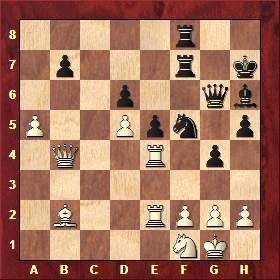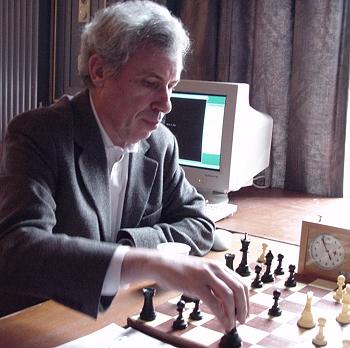


Kasparov won the battle of the openings 3.5-0.5 and could have scored wins in all of the first three games as a result. Fritz' choice in game 1 was described by Kasparov as "childish" in his post-game comments, and indeed it is difficult to justify playing a line that he is known to have studied thoroughly for his match against Deep Junior in January/February. It was said after the match that the Fritz team chose this line because they wanted to prove that their program could handle the line better than Junior, but this surely is no way to plan one's strategy for an encounter with the all-time number one player. Egos should be sacrificed and one should only allow one's program to play lines that suit its style and have the benefit of sound analysis and acceptable evaluations behind them. Fritz survived this game because Kasparov let it off the hook.
 David Levy at the openings ceremony before the Kasparov-X3D Fritz match |
In game 2 Fritz allowed Kasparov to obtain a blocked pawn centre reminiscent of many lines in the Kings Indian. Such positions may be objectively slightly better for white in a human vs human game, but not when playing against a computer program. As Kasparov showed, human players have a better understanding of such positions than do their silicon opponents, so again one must criticize this strategic decision by the Fritz team. The rule should be, avoid positions with blocked pawn centres. Again, Kasparov's failure in this game was just that. Fritz fought very hard but was being steadily steamrollered when Kasparov threw away the game with a grotesque one move blunder.
Game 3 was the worst of all in terms of Fritz' opening strategy. After Black's 5th move ...a6 I was convinced that the program would lose because it would not understand how to play the highly blocked pawn chain. Sure enough its pieces wandered around doing nothing, allowing Kasparov to build up the pressure at will. The result was never in doubt, even though Kasparov felt that the position was, objectively, not clear, and that Black could create counterplay with ...f7-f5 and ...f5-f4. Some programs might well find this plan but it is not Fritz' style.
The opening of game 4 was the only one in which Fritz achieved a position suited to its style. But by the time the players were out of book there were no practical chances for either side and a draw was inevitable. Had Fritz obtained more stylistically suitable positions from the opening in games 1 and 3, the result of the match might have been different.
I felt that Fritz fought extremely hard when in difficult positions. It is a very resilient player, which makes life tough for human opponents who cannot afford to let up the pressure. In game 1 for example, had Kasparov played Bf3 as predicted by the program,(instead of Nf5), he would probably have won. He considered Bf3 but decided, naturally enough, to play the "normal" move Nf5 (from where the knight turned out to have no brilliant future). After this slip it seems likely that there is no longer a winning try for White.

Lessons from the master: Garry Kasparov discussing his games against X3D
Fritz with David Levy (in New York on the day after the end of the match).
A full video recording of Kasparov's analysis can be viewed on the Playchess server.
It is very much to X3D's credit that their virtual reality technology creates an image and an environment in which Kasparov can continue to play at such a high level.

The one real problem for Kasparov related to the rules of play, and something that no-one had considered before the match. In human vs human chess a player picks up a piece, then moves it to its new square and finally releases it. When the piece is in the air, and even when it is on a new square (unless the move is a capture) the player may change his mind about the destination square. So he always sees what the board looks like after he picks up the piece and before he puts it down again. This allows him to spot any important changes in the position, for example something relating to the defence of one or more of his own pieces.

With the virtual reality environment Kasparov was calling out his moves and did not have the luxury of changing his mind when he saw the piece in the air (or on a new square). After the match his second, Yuri Dokhian, asked him simply to remove the rook from the board in game three (instead of playing it to g7), and immediately Kasparov realised that ...Rg7 would be fatal.
For future matches the human player should announce his moves in full notation, so that when he names the "from" square the piece rises above the board, and then when he names the "to" square his move (unless it is a capture) is not completed until he says "OK" or "move" to confirm that he has "taken his hand off" the piece.
David Levy

David Levy, born in London in 1945, won the Scottish Championship at the age of 22 and became an International Master three years later. In 1968 at a Artificial Intelligence workshop in Edinburgh, he played a friendly game against Stanford professor John McCarthy. Levy easily beat the professor, and McCarthy remarked that within ten years there would be a computer program that would beat Levy. The two made a 500 Pound bet, which was later more than doubled when three other computer experts, Donald Michie of Edinburgh University, Seymour Papert from MIT and Ed Kozdrowicki from the University of California, joined in the wager. In August 1978 Levy won his bet when he defeated CHESS 4.7, the strongest chess playing computer of the day, by a score of 3.5-1.5. In 1984 Levy beat Cray Blitz 4-0, and in 1989 lost to Deep Thought 0:4.
From 1994-1997 Levy has managed a team developing natural language processing software, winning the Loebner Prize in the process (widely regarded as the World Championship for conversational software). Today David is the CEO of his own systems development businesses, the principal products being strategy games programs for embedded products, interactive TV system, consultancy services on strategy games and similar projects, intelligent toys.
|
|
|
|
|
|
|
|
|
|
|
|
|
|
|
|
|
|
|
|
|
|
|
|
|
|
|
|